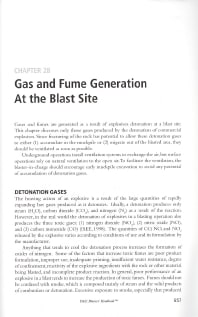Mining Publication: Gas and Fume Generation at the Blast Site
Original creation date: January 2011
Authors: RJ Mainiero
NIOSHTIC2 Number: 20039323
ISEE Blasters' Handbook, 18th edition. Cleveland, OH: International Society of Explosives Engineers, Inc., 2011 Jan; :657-663
Gases and fumes are generated as a result of explosives detonation at a blast site. This chapter discusses only those gases produced by the detonation of commercial explosives. Since fracturing of the rock has potential to allow these detonation gases to either (1) accumulate in the muckpile or (2) migrate out of the blasted area, they should be ventilated as soon as possible. Underground operations install ventilation systems to exchange the air, but surface operations rely on natural ventilation to the open air. To facilitate the ventilation, the blaster-in-charge should encourage early muckpile excavation to avoid any potential of accumulation of detonation gases.

NIOSHTIC2 Number: 20039323
ISEE Blasters' Handbook, 18th edition. Cleveland, OH: International Society of Explosives Engineers, Inc., 2011 Jan; :657-663